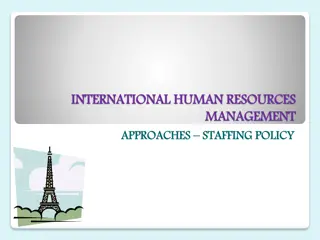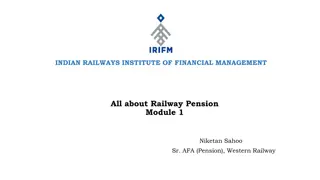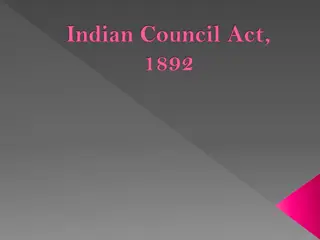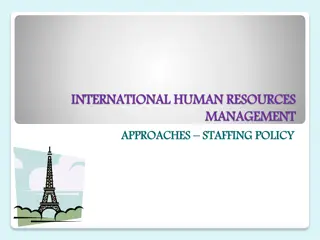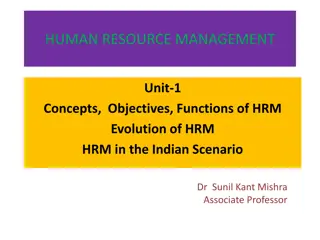Strategic Human Resources Management in Indian Country - SAIGE 2019
This presentation discusses how strategic workforce planning can enhance participation rates from the American Indian and Alaska Native community in agencies with program management responsibilities in Indian country. It covers basic concepts such as strategic human capital management, workforce analytics, and the Human Capital Framework, focusing on strategic planning, talent management, and performance culture.
Download Presentation

Please find below an Image/Link to download the presentation.
The content on the website is provided AS IS for your information and personal use only. It may not be sold, licensed, or shared on other websites without obtaining consent from the author.If you encounter any issues during the download, it is possible that the publisher has removed the file from their server.
You are allowed to download the files provided on this website for personal or commercial use, subject to the condition that they are used lawfully. All files are the property of their respective owners.
The content on the website is provided AS IS for your information and personal use only. It may not be sold, licensed, or shared on other websites without obtaining consent from the author.
E N D
Presentation Transcript
Strategic Human Resources Management Providing Accountability for Your Agency s Mission in Indian Country SAIGE 2019
HYPOTHESIS Agencies with program management responsibilities in Indian country have jobs that are of particular interest to American Indian and Alaska Native professionals. Applying strategic workforce planning concepts can help Agencies increase participation rates from the AI/AN community.
BASIC CONCEPTS 1. 5 CFR Part 250, Subpart B - Strategic Human Capital Management 2. Workforce Analytics DATA!! 3. Human Capital Framework (HCF) definitions and standards for human capital planning, implementation, and evaluation. (a) Strategic planning and alignment. (b) Talent management (c) Performance culture (d) Evaluation 4. Succession Planning
HUMAN CAPITAL FRAMEWORK (HCF) a) Strategic planning and alignment. A system that ensures agency human capital programs are aligned with agency mission, goals, and objectives through analysis, planning, investment, and measurement. The standards for the strategic planning and alignment system require an agency to ensure their human capital management strategies, plans, and practices (1) Integrate strategic plans, annual performance plans and goals, and other relevant budget, finance, and acquisition plans; (2) Contain measurable and observable performance targets; and (3) Communicate in an open and transparent manner to facilitate crossagency collaboration to achieve mission objectives.
HUMAN CAPITAL FRAMEWORK (HCF) b) Talent management A system that promotes a high-performing workforce, identifies and closes skill gaps, and implements and maintains programs to attract, acquire, develop, promote, and retain quality and diverse talent. The standards for the talent management system require an agency to (1) Plan for and manage current and future workforce needs; (2) Design, develop, and implement proven strategies and techniques and practices to attract, hire, develop, and retain talent; and (3) Make progress toward closing any knowledge, skill, and competency gaps throughout the agency.
HUMAN CAPITAL FRAMEWORK (HCF) c) Performance culture A system that engages, develops, and inspires a diverse, high- performing workforce by creating, implementing, and maintaining effective performance management strategies, practices, and activities that support mission objectives. The standards for the performance culture system require an agency to have (1) Strategies and processes to foster a culture of engagement and collaboration; (2) A diverse, results-oriented, high performing workforce; and (3) A performance management system that differentiates levels of performance of staff, provides regular feedback, and links individual performance to organizational goals.
HUMAN CAPITAL FRAMEWORK (HCF) d) Evaluation A system that contributes to agency performance by monitoring and evaluating outcomes of its human capital management strategies, policies, programs, and activities by meeting the following standards (1) Ensuring compliance with merit system principles; and (2) Identifying, implementing, and monitoring process improvements.
ALIGNING EPAS MISSION WITH FTE REQUIREMENTS 1. Where are EPA s Indian country jobs? 2. What type (series and grade) of FTE are needed to achieve EPA s Indian country work load? 3. How can we use strategic work force planning to enhance AI/AN employment opportunities? Placed-based duty stations Culturally and professionally rewarding work Ability to bridge Federal program to local realities in culturally appropriate ways Ability to help dovetail EPA programs with other federal programs etc. (?)
WHERES THE WORK? Indian Country Distribution of Regulated Facilities, Land Area, Water Area, and Population 1 2 3 4 5 6 7 8 9 10 EPA Regions
WHERESTHEWORK? Indian Country Distribution of Regulated Facilities, Land Area, Water Area, Population (water program data only ) 1 2 3 4 5 6 7 8 9 10 EPA Regions
WHERESTHEWORK? Indian Country Distribution of Regulated Facilities, Land Area, Water Area, Population Across Tribes in EPA R08 (water program data only ) 18% 120% 16% 100% 14% 4 tribes in EPA R8 have 53% of all R8 Indian country water program impacts 12% 80% 10% 60% 8% 6% 40% 4% 20% 2% 0% 0% Tribes in EPA R08
















